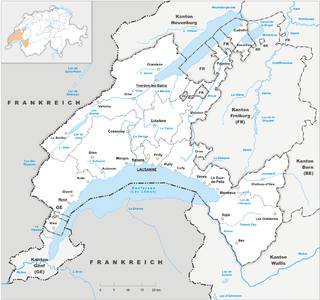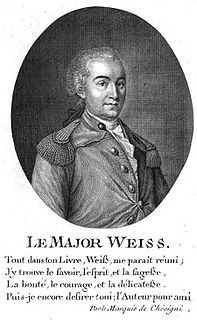
The following is an alphabetical list of articles related to Switzerland.

Vaud, more formally the canton of Vaud, is one of the 26 cantons forming the Swiss Confederation. It is composed of ten districts and its capital city is Lausanne. Its flag bears the motto "Liberté et patrie" on a white-green background.

The canton of Bern or Berne is one of the 26 cantons forming the Swiss Confederation. Its capital city, Bern, is also the de facto capital of Switzerland. The bear is the heraldic symbol of the canton, displayed on a red-yellow background.

The Old Swiss Confederacy began as a late medieval alliance between the communities of the valleys in the Central Alps, at the time part of the Holy Roman Empire, to facilitate the management of common interests such as free trade and to ensure the peace along the important trade routes through the mountains. The Hohenstaufen emperors had granted these valleys reichsfrei status in the early 13th century. As reichsfrei regions, the cantons of Uri, Schwyz, and Unterwalden were under the direct authority of the emperor without any intermediate liege lords and thus were largely autonomous.

Chillon Castle is an island castle located on Lake Geneva, south of Veytaux in the canton of Vaud. It is situated at the eastern end of the lake, on the narrow shore between Montreux and Villeneuve, which gives access to the Alpine valley of the Rhône. Chillon is amongst the most visited medieval castles in Switzerland and Europe. Successively occupied by the House of Savoy then by the Bernese from 1536 until 1798, it now belongs to the State of Vaud and is classified as a Swiss Cultural Property of National Significance. The Fort de Chillon, its modern counterpart, is hidden in the steep side of the mountain.

Payerne is a municipality in the Swiss canton of Vaud. It was the seat of the district of Payerne, and is now part of the district of Broye-Vully. The German name Peterlingen for the town is out of use.

Lucens is a municipality in the Broye-Vully district in the canton of Vaud in Switzerland. In 2017 the former municipalities of Brenles, Chesalles-sur-Moudon, Cremin, Forel-sur-Lucens and Sarzens merged into the municipality of Lucens.

The Battle of Laupen was fought in June 1339, between Bern and its allies on one side, and Freiburg together with feudal landholders from the County of Burgundy and Habsburg territories on the other. Bern was victorious, consolidating its position in the region. As a consequence of the conflict, the relations of Bern and the Swiss Confederacy tightened, resulting in Bern's permanent accession in 1353.

Forel-sur-Lucens is a former municipality in the district Broye-Vully in the canton of Vaud in Switzerland. In 2017 the former municipalities of Forel-sur-Lucens, Brenles, Chesalles-sur-Moudon, Cremin and Sarzens merged into the municipality of Lucens.

The city of Bern is one of the Zähringer foundations of the late 12th century. By the end of the 13th century, it had acquired de facto imperial immediacy. It became a full member of the Old Swiss Confederacy in 1353, and during the 15th century managed to significantly expand its sphere of influence, notably with the conquest of Aargau in 1415. With the acquisition of Vaud in 1536, Bern became the most powerful city-republic north of the Alps, and one of the leading Protestant cities in early modern Switzerland. The canton of Bern in the Restored Confederacy of 1815 even after the loss of Aargau and Vaud remained the largest Swiss canton, relegated to second rank only with the secession of Jura in 1979. Since 1848 Bern has served as the federal city (capital) of Switzerland.

Château Saint-Maire is a castle in Lausanne, Switzerland, that serves as the seat of the cantonal government, the Council of State of Vaud. It is a Swiss heritage site of national significance.

Rolle Castle is a castle in the municipality of Rolle of the Canton of Vaud in Switzerland. It is a Swiss heritage site of national significance.

Baillival Castle (Bulle) is a bailiff's castle in the municipality of Bulle of the Canton of Fribourg in Switzerland. It is a Swiss heritage site of national significance.

Baillival Castle (Surpierre) is a bailiff's castle in the municipality of Surpierre of the Canton of Fribourg in Switzerland. It is a Swiss heritage site of national significance.

Münchenwiler Castle or Château de Villars-les-Moines is a castle and former Cluniac priory in the municipality of Münchenwiler of the Canton of Bern in Switzerland. It is a Swiss heritage site of national significance.

Erguel Castle is a ruined castle in the municipality of Sonvilier in the canton of Bern in Switzerland. It is the best preserved castle ruin in the French-speaking Bernese Jura.

Mülenen Castle and the attached Letzi Mülenen wall are a ruined medieval fortification in the village of Mülenen and municipality of Reichenbach im Kandertal, in the Swiss canton of Bern. The Letzi Mülenen is a Swiss heritage site of national significance.
Military use of schools is a term used to refer to the various activities that national armed forces and non-state armed groups carry out in and around schools, universities, and other education facilities, in support of their military effort. Examples of this include using a school or a university as barracks or bases, for offensive or defensive deployments, for storage of weapons or ammunition, for military training of soldiers, as observation posts, and as a detention facility.
The Safe Schools Declaration is an inter-governmental political commitment that was opened for endorsement by countries at an international conference held in Oslo, Norway, on 28–29 May 2015. The Declaration provides countries the opportunity to express political support for the protection of students, teachers, and schools during times of armed conflict; the importance of the continuation of education during armed conflict; and the implementation of the Guidelines for Protecting Schools and Universities from Military Use during Armed Conflict.

François-Rodolphe de Weiss (1751–1818) was a Swiss political and military leader, writer and philosopher, a follower of Jean-Jacques Rousseau.





















